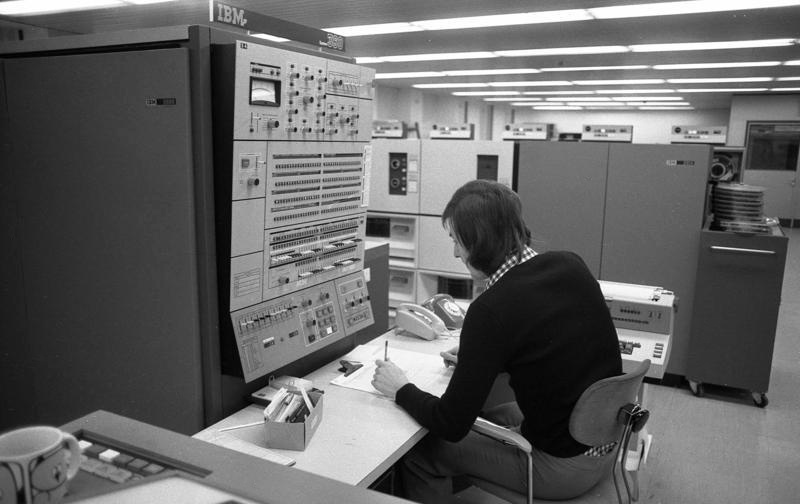he History of Computing
•1623-1662: Blaise Pascal is a French mathematician and a philosopher,he invented the Pascaline in 1642.

•1642: The Pascaline is a single revolution of one wheel would engage gears that turned the wheel one tenth of a revolution to its left.
 •1801:Jacquard's Loom(Frenchman Joseph Marie Jacquard(1753-1871)).This is the first significant use of binary automation.
•1801:Jacquard's Loom(Frenchman Joseph Marie Jacquard(1753-1871)).This is the first significant use of binary automation.
•1793-1871:Charles Babbage envisioned a steam-powered difference engine and then an analytical engine.
 •1816-1852:Lady Ada Augusta punched cards could be prepared to instruct Babbage's engine to repeat certain options,she is the first programmer.
•1816-1852:Lady Ada Augusta punched cards could be prepared to instruct Babbage's engine to repeat certain options,she is the first programmer.
 •1860-1929:Herman Hollerith denoised a punched-card tabulating machine to speed up the 1890 U.S. census.
•1860-1929:Herman Hollerith denoised a punched-card tabulating machine to speed up the 1890 U.S. census.
 •1890:Hollerith's Tabulating Machine used a hand punch to enter data onto cards.
•1890:Hollerith's Tabulating Machine used a hand punch to enter data onto cards.
•1874-1956:Thomas Watson Sr. in 1896 Herman Hollerith founded the Sabulating Machine Company. International Business Machine Corporation(IBM)by company president Thomas J. Watson in 1924.
 •1920-1950:The Electro-Mechanical Accounting Machine Era a punched-card technology
•1920-1950:The Electro-Mechanical Accounting Machine Era a punched-card technology

•1903-1995: Dr.John V. Atanasoff and his ABC(Atanasoff Berry Computer)this is the first electronic digital computer;The ABC.
•1946:The Electronic ENIAC computer(Dr.John W. Mauchly, Presper Eckert Jr.)used vacuum tubes.
•1951:The UNIVAC 1 the first generation of computer.The first commercially variable elctronic digital computer.
•1954:The IBM 650 introduced in 1954,was designed as a logical upgrade to existing punched-card machine.
•1907-1992:"Amazing" Grace Murray Hopper found the first "bug" in a computer-a real one.
 •1958:The First Integrated Circuit is a phase-shift oscillator, was invented in 1958 by Jack S. Kilby of Texas Instruments.
•1958:The First Integrated Circuit is a phase-shift oscillator, was invented in 1958 by Jack S. Kilby of Texas Instruments.
 •1963:The PDP-8 Minicomputer is the first successful minicomputer by Digital Equipment Corporation.
•1963:The PDP-8 Minicomputer is the first successful minicomputer by Digital Equipment Corporation.
 •1964:The IBM System/360 and The Third Generation of Computers the third generation was characterized by computers built around integrated circuits.
•1964:The IBM System/360 and The Third Generation of Computers the third generation was characterized by computers built around integrated circuits.
•1964:Basic-More Than a Beginner's Programming Language Dr. Thomas Kurtz and Dr.John of Dartmouth College developed a programming language that a beginner could learn and use quickly.

•1969: APRANET and Unbindling of Hardware and Software a V.S. Department of Defense's Advanced Research Project Agency(ARPA) sponsorship of a project named ARPANET.
 •1975:Microsoft and Bill Gates, Bill Gates and Paul Allen formed Microsoft Corporation.
•1975:Microsoft and Bill Gates, Bill Gates and Paul Allen formed Microsoft Corporation.
 •1976:The Apple 1 Steve Jobs and Steve Wozniak along with Ronald G. Wayne formed the Apple computer Company.
•1976:The Apple 1 Steve Jobs and Steve Wozniak along with Ronald G. Wayne formed the Apple computer Company.
 •1981:The IBM PC, IBM tossed its hat into the personal computer ring its announcement of the IBM Personal Computer.
•1981:The IBM PC, IBM tossed its hat into the personal computer ring its announcement of the IBM Personal Computer.
 •1982:Mitchell Kapor Designs Lotus 1-2-3, in 1982, Kapor founded lotus Development Company.
•1982:Mitchell Kapor Designs Lotus 1-2-3, in 1982, Kapor founded lotus Development Company.
 •1984:The Macintosh and Graphical User Interfaces, Apple computer introduced the Macintosh desktops computer with a very friendly Graphical User Interfaces.
•1984:The Macintosh and Graphical User Interfaces, Apple computer introduced the Macintosh desktops computer with a very friendly Graphical User Interfaces.
•1985-Present:Microsoft Windows Microsoft introduced Windows, a GUI for IBM PC-compatible computer in 1985.
•1989:The World Wide Web Berners-Lee and a small team of scientists convinced HTML (the language of the internet), URLs(Internet Addresses), and put up the first server supporting the new world wide web format.
 •1993:The Internet Browser, the development in 1993 of the graphical browser mosaic Marc Andersen and his team.
•1993:The Internet Browser, the development in 1993 of the graphical browser mosaic Marc Andersen and his team.
 •1996:The Hand Held Computer, the Palm Pilot hand held computer was introduced by Palm Computing Inc.
•1996:The Hand Held Computer, the Palm Pilot hand held computer was introduced by Palm Computing Inc.
As a student I learned that the history of computing is updating and updating into a better ones.
























